Böhmen |
|
|
|
| Übersicht – Contents: | |
Böhmen |
|
|
|
| Übersicht – Contents: | |
Flaggen – Flags: |
|
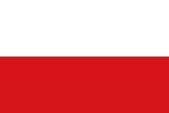 |
Landesflagge (Landesfarben) – Flag of the country (colours), Seitenverhältnis – ratio = 2:3, Quelle/Source nach/by: Flags of the World |
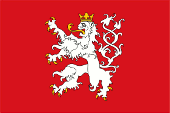 |
ca. 15.–18. Jhd. Flagge des Königreichs Böhmen – Flag of the Kingdom of Bohemia, Quelle/Source nach/by: Jakob Köbel, 1540, Nördlingen |
|
|
|
Bedeutung/Ursprung der Flagge – Meaning/Origin of the Flag: |
|
| In alter Zeit waren in Böhmen, wie in anderen Ländern auch, zunächst Wappenflaggen üblich. Das heißt, das Bild des Wappens wurde auf die Flagge übertragen. Im Falle Bömens war das der silberne, bekrönte, zweischwänzige, golden bewehrte Löwe auf rotem Grund. Diese Praxis war in der Zeit nach dem Dreißigjährigen Krieg für Böhmen kaum noch wichtig. Das Land war befriedet, nicht mehr umkämpft und gehörte als Erbland endgültig zum Haus Habsburg, als Hausmacht der Deutschen Kaiser die meistens aus dem Haus Habsburg kamen. Dadurch trat die Repräsentation Böhmens, wie anderer Länder der Hausmacht auch, in den Hintergrund. Die Wappenflagge verblieb lediglich als Symbol des Königtums. Die Farben Weiß und Rot prägten sich aber als Farben Böhmens ein und wurden zum Mittel der Identifikation, die später auch auch auf Flaggen gezeigt wurden. | In old times, in Bohemia, as in other countries, escutcheon-flags were common at first. That means, that the image of the coat of arms was transferred to the flag. In the case of Bohemia, this was the silver, crowned, two-tailed, golden armed lion on a red background. This practice was not so important anymore for Bohemia in the period after the Thirty Years' War. The country was pacified, no longer disputed and finally belonged as hereditary to the House of Habsburg, as the house power of the German emperors, most of whom came from the House of Habsburg. As a result, the representation of Bohemia, like other countries of the house power, stepped into the background. The coat of arms flag remained only as a symbol of the kingship. The colours white and red, however, were memorized as colours of Bohemia and became a thing of identification, which were later also shown on flags. |
| Das Land hatte, wie alle Kronländer der österreichischen Krone, so seine eigenen, sogenannten Landesfarben, die unter anderem auf horizontal getreiften zwei- oder dreistreifigen Flaggen gezeigt wurden. Die Landesfarben waren sehr oft dem jeweiligen Wappen des Kronlandes entnommen oder wurden duch eine weitere, nicht im Wappen enthaltene Farbe ergänzt, oder sie gingen auf ältere Modelle des Landeswappens zurück (z.B. Krain). Offiziell waren die Landesfarben aber nie geregelt oder festgelegt worden, so dass deren Reihenfolge in der Praxis of variierte oder die Farben gar an sich abwichen. Der österreichische Heraldiker Hugo Gerard Ströhl (1851–1919) hat sich wohl als erster des Themas angenommen und wahrscheinlich um das Jahr 1890 herum die Landesfarben auf den Flaggen bei den jeweiligen Landesbehörden abgefragt und zusammengestellt: |
The country had
in this way – like all the other crown lands of the Austrian
crown – its own colours (Landesfarben), which were used amongst others on
horizontally two- or three-striped flags. The colours (Landesfarben) were very often taken from the respective coat of arms of the country or were supplemented by another colour, which not appears in the coat of arms, or they went back to older models of the coat of arms (e.g. Carniola). Officially, the colours had never been regulated or stipulated, so that their sequence varied in practice or even the colors deviated. The Austrian heraldist Hugo Gerard Ströhl (1851–1919) was probably the first to take care of it and asked for the colors (Landesfarben) on the flags at the respective state authorities around 1890 and compiled them: |
| Das Kronland Böhmen verwendete als Landesfarben eine Flagge die zwei horizontale Streifen in Weiß und Rot zeigte. | The crown land of Bohemia used as colours of the country a flag which showed two horizontal stripes in white and red. |
| Quelle/Source: Österreichisch-Ungarische Wappenrolle, Volker Preuß | |
Wappen – Coat of Arms: |
|
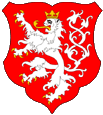 |
Wappenschild Königreich Böhmen – Escutcheon of the Kingdom of Bohemia, Quelle/Source: nach/by: Österreichisch-Ungarische Wappenrolle |
 |
650–1306 Wappen der Przemysliden Dynastie – Coat of arms of the Přemyslid dynasty, Quelle/Source: nach/by: Wikipedia (D) |
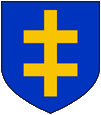 |
1471–1526 Wappen der Jagiellonen Dynastie – Coat of arms of the Jagiellonian dynasty, Quelle/Source: nach/by: Wikipedia (D) |
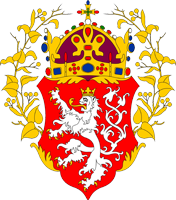 |
ca.1890–1918, Wappen Königreich Böhmen – Coat of arms of the Kingdom of Bohemia, Quelle/Source, nach/by: Ströhl, Wappenrolle Österreich-Ungarns, 1890, via Wikipedia (D) |
 |
1920–1939, 1945–1960, mittleres Wappen der Tschechoslowakei – middle coat of arms of Czechoslovakia, Quelle/Source: nach/by: See page for author / CC BY-SA |
 |
heutiges Wappen von Tschechien – today's Coat of arms of Czechia, Quelle/Source nach/by: unknown, convert to SVG Tlusťa / Public domain |
 |
heutige Heraldik von Böhmen – today's heraldry of Bohemia, Quelle/Source nach/by: unknown, convert to SVG Tlusťa / Public domain |
Bedeutung/Ursprung des Wappens – Meaning/Origin of the Coat of Arms: |
|
| Das Wappen Böhmens zeigt einen silbernen zweischwänzigen Löwen mit goldener Krone und goldener Bewehrung auf blauem Schild. | The coat of arms of Bohemia shows a silvery double tailed lion with a golden crown and golden arms on a red shield. |
| Die böhmische Heraldik des silbernen Löwen auf Rot geht bis ins 12./13. Jahrhundert zurück, wahrscheinlich sogar bis ins 11. Jahrhundert. Der Löwe war wahrscheinlich schon immer doppelschwänzig, denn manchmal wird behauptet, dass der zweite Schwanz von Kaiser Otto IV. für militärische Verdienste Anfang des 13. Jahrhunderts verliehen worden sei. | The Bohemian heraldry of the silvery lion on red geht has its roots in the 12th/13th century, probably even in the 11th century. The lion was probably always double tailed, because sometimes there are allegations that the second tail should have been awarded by Emperor Otto IV. for military merites in the beginning of the 13th century. |
| Als Habsburgisches Kronland trug das Wappen die Böhmische Königskrone. Diese war im Jahre 1347 von Kaiserin Bianca de Valois in Auftrag gegeben worden. Der österreichische Heraldiker Hugo Gerard Ströhl hat das Wappen um 1890, in seiner letzten bekannten Ausführung, mit einem Kranz aus Lindenzweigen umgeben. Die Lindenzweige bleiben auch nach der Zeit als Österreichisches Kronland im Wappen der Tschechoslowakei bis 1992 erhalten. Heute sind sie noch in der Flagge des Präsidenten von Tschechien zu sehen. | As an Habsburg crown
land the coat of arms of the country showed above the Bohemian royal crown.
That was commissioned by Empress Bianca de Valois in 1347.
The Austrian heraldist Hugo Gerard Ströhl surrounded the coat of arms ca. 1890, in its last known version, with a wreath of linden branches. The linden branches remained in the coat of arms of Czechoslovakia even after the time as an Austrian crown land until 1992. Today they can still be seen in the flag of the President of the Czech Republic. |
| Böhmens Heraldik erschien noch bis 1960 im Wappen der Tschechoslowakei. Seit 1992 erscheint der Löwe wieder im Wappen von Tschechien. | The heraldry of Bohemia appeared still until 1960 in the coat of arms of Czechoslovakia. Since 1992 appears the lion again in the coat of arms of Czechia. |
| Quelle/Source: Österreichisch-Ungarische Wappenrolle, Wikipedia (D), Volker Preuß | |
|
Lesen Sie hier: Hintergründe, Geschichte und Fakten zum Thema "Der Löwe in der Heraldik". Ausführungen, Varianten, Entwicklung sowie Panther und Leoparden. |
 |
| Die Kronländer Österreich-Ungarns – Crown Lands of Austria-Hungary: |
|
| Quelle/Source: Volker Preuß |
Zahlen und Fakten – Numbers and Facts: |
|
|
|
|
|
|
|
|
|
|
|
|
|
|
|
|
|
|
Geschichte: |
| Antike ·
Besiedlung durch den keltischen Stamm der Boier 80–70 v.Chr. · Besiedlung durch den germanischen Stamm der Markomannen 6. Jahrhundert · die Awaren drängen die slawischen Völker in Richtung Westen vor sich her, der slawische Stamm der Tschechen erreicht die Siedlungsgebiete der Markomannen, die Markomannen wandern größtenteils nach Bayern ab ca. 620 · der Franke Samo vereint die slawischen Völker der Sorben, Kroaten, Doudleben, Tschechen, Mährer und Slowaken und stoppt den Vormarsch der Awaren, das "Samoreich" (heutiges Sachsen, Böhmen, Mähren, Westslowakei) besteht bis zu seinem Tode und zerfällt dann wieder in die einzelnen Stämme ca. 650 · Beginn der sagenhaften und legendenartigen tschechischen Frühgeschichte: König Krok, die weise Libussa, Przemysl der Herr von Staditz, die Gründung von Prag. Die Söhne Przemysls werden tschechische Stammesherzöge (Przemysliden), Böhmen muss nach mehreren Feldzügen die Oberhoheit des fränkischen Reiches anerkennen ca. 880 · Swatopluk der Herzog von Mähren (später König) unterwirft die Tschechen in Böhmen und dehnt seine Herrschaft bis ins heutige Sachsen aus 894 · Tod von König Swatopluk, Kämpfe zwischen seinen Söhnen Mojmir II. und Swatopluk II., unter Herzog Spitihniew I. werden die Tschechen von Mähren unabhängig, schwören dem fränkischen König Arnulf die Treue und kommen unter fränkische Oberhoheit 929 · Herzog Wenzel (Neffe von Spitihniew I.) anerkennt die Oberhoheit des deutschen Königs Heinrich I. (Lehnseid) 950 · Boleslaw I. (Bruder von Wenzel) anerkennt die Oberhoheit des deutschen Königs Otto I. (Lehnseid) 967 · Boleslaw II. (Sohn von Boleslaw I.) anerkennt die Oberhoheit des deutschen Königs Otto I. (Lehnseid) 999 · Boleslaw III. (Sohn von Boleslaw II.) anerkennt die Oberhoheit des deutschen Königs Otto II. (Lehnseid) ca. 1002 · Herzog Boleslaw III. erobert Mähren, regiert in Böhmen äußerst grausam und wird letztlich vom Volk vertrieben 1003 · Boleslaw Chrobry, der Herzog von Polen, fällt in Böhmen ein und bemächtigt sich des Landes 1004 · der deutsche König Heinrich II. vertreibt die Polen aus Böhmen und setzt die Przemysliden wieder als Herzöge ein 1029 · Bretislaw I. , Sohn des böhmischen Herzogs Udalrich, erobert Mähren zurück, die Söhne des Herzogs von Böhmen sind künftig die Herzöge von Mähren 1055 · Tod von Bretislaw I., Senioratserbfolge, Bürgerkrieg 1061 · Bretislaw II. , Sohn von Bretislaw I. wird Herzog von Böhmen 1086 · der deutsche Kaiser Heinrich IV. erhebt Bretislaw II. zum König von Böhmen (nicht erblich) 1092 · Tod von Bretislaw II., sein Sohn Bretislaw III. wird Herzog von Böhmen 1100 · Tod von Bretislaw III., Erbfolgekrieg 1125 · Sobieslaw setzt sich in der Erbfolge durch 1126 · Sobieslaw anerkennt die Oberhoheit des deutschen Königs Konrad II. (Lehnseid) 1140 · Wladislaw II., Nachfolger von Sobieslaw, wird Herzog von Böhmen und wenig später von den Tschechen aus Prag vertrieben, der deutsche König Konrad II. setzt in wieder als Herzog von Böhmen ein 1158 · der deutsche Kaiser Friedrich I. erhebt Wladislaw II. zum König von Böhmen (erblich) 1174 · Tod von König Wladislaw II., Erbfolgekrieg 1197 · Ottokar I. setzt sich in der Erbfolge durch, der deutsche Kaiser Friedrich II. erhebt Ottokar I. zum König von Böhmen (erblich) 1253 · Ottokar II. (1253-1278), erwirbt das Herzogtum Österreich nach dem Aussterben des Hauses Babenberg 1260 · Schlacht auf dem Marchfeld gegen die Ungarn, Ottokar II. erwirbt Steiermark 1269 · Ottokar II. erwirbt Kärnten 1270 · Ottokar II. erwirbt Krain 1254 · Kreuzzug Ottokars II. mit dem Deutschen Ritterorden gegen die heidnischen Preußen, Gründung der Stadt Königsberg (Benannt nach König Ottokar) 1273 · Wahl von Rudolf von Habsburg zum deutschen König, König Ottokar II. erkennt diesen als Lehnsherrn nicht an, es folgt ein Krieg 1276 · Frieden von Wien, Böhmen muss Steiermark, Kärnten und Krain an das Haus Habsburg abtreten 1278 · Schlacht auf dem Marchfeld, König Ottokar II. fällt im Kampf 1283–1306 · die Nachfolger Ottokars (Wenzel II. und Wenzel III.) bringen die Kronen Polens und Ungarns an Böhmen 1306 · Tod von Wenzel III. (ungarischer König Ladislaus V.), Aussterben der Przemysliden 1306–1307 · der Habsburger Rudolf ist König von Böhmen 1307–1310 · Heinrich von Görz ist König von Böhmen 1310 · das Haus Luxemurg erwirbt Böhmen 1335 · Verzicht auf die polnische Krone 1346–1378 · der Kaiser des Deutschen Reiches Karl IV., aus dem Hause Luxemburg, ist gleichzeitig König von Böhmen, Blütezeit des Landes 1419–1436 · Hussitenkriege 1469 · Matthias Corvinus , König von Ungarn, wird König von Böhmen 1471 · Wladislaw von Polen, aus dem Haus der Jagiellonen, wird König von Böhmen 29.08.1526 · Türkenschlacht bei Mohács, Tod des letzten Jagiellonen, Erzherzog Ferdinand von Österreich aus dem Haus Habsburg wird zum König von Böhmen gewält 1547 · Ferdinand von Österreich, inzwischen Ferdinand I., Kaiser des Deuschen Reiches, macht den Titel des Königs erblich 1556 · das Haus Habsburg teilt sich in eine spanische und eine österreichische Linie, Böhmen kommt zur Spanischen Linie 26.08.1619 · die böhmischen Stände wählen den Kurfürsten Friedrich V. von der Pfalz zum (Gegen-)König 08.11.1620 · Schlacht am Weißen Berg bei Prag, Friedrich V. wird von den kaiserlich-katholischen Truppen geschlagen, Dreißigjähriger Krieg in Deutschland, Böhmen wird endgültig Habsburgische Erbmonarchie 1740–1745 · Österreichischer Erbfolgekrieg 1848/1849 · Revolution in Wien, Franz Joseph I. von Habsburg wird neuer Kaiser, neue Verfassung: die Titular-Erblande der Habsburger im Kaiserreich Österreich werden zu Kronländern mit eigenen Landtagen umgewandelt, Böhmen wird so ein Kronland des Kaiserreichs Österreich, Slawenkongress in Prag, Herausbildung des tschechischen Nationalbewusstseins und des antideutschen Nationalismus 28.10.1918 · die Tschechoslowakei spaltet sich von Österreich-Ungarn ab (am 10.09.1919 von Österreich anerkannt), Böhmen wird dabei in die Tschechoslowakei eingegliedert 10.10.1938 · Münchner Abkommen, die Tschechoslowakei muss die mehrheitlich von Deutschen bewohnten Gebiete, und damit Teile Böhmens, an das Deutsche Reich abtreten, diese werden mit anderen Territorien zum Gau Sudetenland zusammengefasst 15.03.1939 · Einmarsch deutscher Truppen in Prag, die Tschechoslowakei wird aufgelöst, die Slowakei wird ein eigener Staat, die verbliebenen Gebiete werden "Reichsprotektorat Böhmen und Mähren" 1945 · sowjetische Eroberung und Besetzung Böhmens, Wiederangliederung an die Tschechoslowakei, Vertreibung und teilweise auch Ermordung des größten Teils der im Lande verbliebenen deutschen Zivilbevölkerung 1992 · Zerfall der Tschechoslowakei in Tschechien (Böhmen, Mähren und ehemals Österreichisch-Schlesien) und Slowakei |
History: |
| Antiquity
· settlement by the Celtic tribe of the Boii 80–70 B.C. · settlement by the Teutonic tribe of the Marcomanni 6th century · the Awars shove the Slavic nations in western direction, the Slavic tribe of the Czech reaches the territorities of the Marcomanni, the Marcomanni mostly move away to Bavaria ca. 620 · Samo the Frank unites the Slavic nations of the Sorbs, Croats, Doudlebs, Czech, Moravians and Slovaks and stops the advance of the Awars, the "Samo Empire" (today’s Saxony, Bohemia, Moravia, Western Slovakia) exists until his death and disintegrates then in the particular tribes again ca. 650 · onset of the fabulous and legendary Czech early history: King Krok, the wise Libussa, Przemysl the Lord of Staditz, the foundation of Prague. The sons of Przemysls become Czech tribal dukes (Przemyslids), Bohemia has to recognize the Frankish supremacy after several campaigns ca. 880 · Svatopluk the Duke of Moravia (later king) submits the Czech in Bohemia and expands its control to the today’s Saxony 894 · death of King Svatopluk, conflicts between its sons Mojmir II. and Svatopluk II., the Czech become independent under Duke Spitihniew I. from Moravia, they swear loyalty to the Frankish King Arnulf and come under Frankish supremacy 929 · duke Wenzel (nephew of Spitihniev I.) recognizes the supremacy of the German King Heinrich I. (oath of fiefdom) 950 · Boleslav I. (brother of Wenzel) recognizes the supremacy of the German King Otto I. (oath of fiefdom) 967 · Boleslav II. (son of Boleslav I.) recognizes the supremacy of the German King Otto I. (oath of fiefdom) 999 · Boleslav III. (son of Boleslav II.) recognizes the supremacy of the German King Otto II. (oath of fiefdom) ca. 1002 · Duke Boleslav III. conquers Moravia, rules in Bohemia very dreadful and becomes finally banished by the people 1003 · Boleslav Chrobry, the Duke of Poland, invades in Bohemia and comes over the country 1004 · the German King Henry II. banishes the Polish out of Bohemia and appoints again the Przemyslids as dukes 1029 · Bretislav I. , son of the Bohemian Duke Udalrich, conquers Moravia back, the sons of the Duke of Bohemia are prospective the Dukes of Moravia 1055 · death of Bretislav I., succession of seniors, civil war 1061 · Bretislav II. , son of Bretislav I. becomes Duke of Bohemia 1086 · the German Emperor Henry IV. levies Bretislav II. to the King of Bohemia (not heritable) 1092 · death of Bretislav II., his son Bretislav III. becomes Duke of Bohemia 1100 · death of Bretislav III., war of succession 1125 · Sobieslav achieves in succession 1126 · Sobieslav recognizes the supremacy of the German King Conrad II. (oath of fiefdom) 1140 · Vladislav II., successor of Sobieslav, becomes Duke of Bohemia and becomes any times later banished out of Prague by the Czech, the German King Conrad II. appoints him again as Duke of Bohemia 1158 · the German Emperor Frederick I. levies Vladislav II. to the King of Bohemia (heritable) 1174 · death of King Vladislav II., war of succession 1197 · Ottokar I. achieves in succession, the German Emperor Frederick II. levies Ottokar I. to the King of Bohemia (heritable) 1253 · Ottokar II. (1253-1278), earns the Duchy of Austria after the vanish of the House of Babenberg 1260 · battle on the March Field against the Hungarians, Ottokar II. earns Styria 1269 · Ottokar II. earns Carinthia 1270 · Ottokar II. earns Carniola 1254 · crusade of Ottokar II. with the Order of the Teutonic Knights against the pagan Prussians, foundation of Koenigsberg Town (named after King Ottokar) 1273 · election of Rudolf of Habsburg to the German king, King Ottokar II. recognizes him not as Lord of Fiefdom, a war follows 1276 · Peace of Vienna, Bohemia has to cede Styria, Carinthia and Carniola to the House of Habsburg 1278 · battle on the March Field, King Ottokar II. falls in the combat 1283–1306 · the successors of Ottokar (Wenzel II. and Wenzel III.) brings the crowns of Poland and Hungary to Bohemia 1306 · death of Wenzel III. (Hungarian King Ladislaus V.), vanish of the Przemyslids 1306–1307 · Rudolf of Habsburg is King of Bohemia 1307–1310 · Heinrich of Goerz is King of Bohemia 1310 · the House of Luxemurg earns Bohemia 1335 · renounce of the Polish crown 1346–1378 · the Emperor of the German Empire Charles IV., from the House of Luxemburg, is concurrent King of Bohemia, flowering period of the country 1419–1436 · Hussite Wars 1469 · Matthias Corvinus , King of Hungary, becomes King of Bohemia 1471 · Vladislav of Poland, from the House of the Jagiellonians, becomes King of Bohemia 29th of August 1526 · Turks Battle near Mohács, death of the last of the Jagiellonians, Archduke Ferdinand of Austria, from the House of Habsburg, becomes elected to the King of Bohemia 1547 · Ferdinand of Austria, meanwhile Ferdinand I., Emperor of the German Empire, makes the king's title heritable 1556 · the House of Habsburg divides itself in a Spanish and in a Austrian line, Bohemia comes to the Austrian line 26th of August 1619 · the Bohemian rank members elect the Elector Frederick V. of Palatinate to the (Anti-)King 8th of November 1620 · battle near the White Montain near Prague, Frederick V. is beaten by imperial-catholic troops, Thirty-Years-War in Germany, Bohemia becomes irrevocably a Habsburg's heritable monarchy 1740–1745 · Austrian War of Succession 1848/1849 · revolution in Vienna, Franz Joseph I. of Habsburg becomes new Emperor, new constitution: the titular hereditary territories of the Habsburgs in the Austrian Empire become converted to crown lands with their own Landtag (parliament), Bohemia becomes in this way a crown land of the Austrian Empire, Slavs Congress in Prague, evolution of the Czech national consciousness and the anti-German nationalism 28th of October 1918 · Czechoslovakia separates from Austria-Hungary (on 10th of September 1919 recognized by Austria), Bohemia becomes in this way incorporated in Czechoslovakia 10th of October 1938 · Munich Agreement, Czechoslovakia has to cede all the in majority by Germans inhabited territories – and in this way parts of Bohemia – to the German Empire, these become summarized with other territories in the Gau of Sudetenland 15th of March 1939 · march in of German troops in Prague, the Czechoslovakia becomes dissolved, Slovakia becomes an own state, the remaining regions become the "Reichs Protectorate of Bohemia and Moravia" 1945 · soviet conquest and occupation of Bohemia, re-incorporation to Czechoslovakia, expulsion and partially even assassination of the largest part of the in the country remained German civilian population 1992 · disintegration of Czechoslovakia in Czechia (Bohemia, Moravia and former Austrian Silesia) and Slovakia |
| Quelle/Source: Atlas zur Geschichte, Wikipedia (D), RetroBib Retrobibliothek, Discovery '97, Volker Preuß |
Ursprung des Landesnamens – Origin of the Country's Name: |
|
| Wenn es um das Land geht, spricht man normalerweise von "Böhmen", meint man dessen heutige Bewohner, spricht man von "Tschechen". Der Name "Böhmen" geht auf den keltischen Stamm der Boier zurück, der hier in der Antike siedelte. Die Boier wurden 80–70 v.Chr. von den germanischen Markomannen verdrängt. Die slawischen Tschechen besiedelten das Land im 6. Jahrhundert. Die tschechische Bezeichnung "Cesko", also "Tschechei" oder "Tschechien", kam erst im 19. Jahrhundert mit den Erstarken des tschechischen Nationalismus auf. | Is meaned
the country there is to speak about "Bohemia", are meaned its today's
residents there is to speak about "Czech". The designation "Bohemia" has its roots in the Celtic tribe of the Boii, which settled here in the antquity. The Boii were pushed aside 80–70 B.C. by the Teutonic Marcomanni. The Slavic Czech populated the country in the 6th century. The Czech designation "Cesko" – ergo "Czechia" – arised not until the 19th century in context with the growing strong of the Czech nationalism. |
| Quelle/Source: Handbuch der geographischen Namen, Volker Preuß | |
| • Reich der Österr. Habsburger (bis 1804) • Kaiserreich Österreich (1804–1867) • Österreich-Ungarn (1867–1918) • Republik Österreich (seit 1918) |
• Empire of the Austrian Habsburgs (to 1804) • Empire of Austria (1814–1867) • Austria-Hungary (1867–1918) • Republic of Austria (since 1918) |